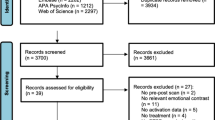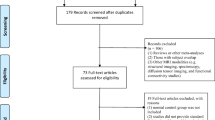Abstract
Purpose
The purpose of this study was to characterize the neurophysiological and clinical effects that may result from the neuro emotional technique (NET) in patients with traumatic stress symptoms associated with a cancer-related event. We hypothesized that self-regulatory processing of traumatic memories would be observable as physiological changes in key brain areas after undergoing the NET intervention and that these changes would be associated with improvement of traumatic stress symptoms.
Methods
We enrolled 23 participants with a prior cancer diagnosis who expressed a distressing cancer-related memory that was associated with traumatic stress symptoms of at least 6 months in duration. Participants were randomized to either the NET intervention or a waitlist control condition. To evaluate the primary outcome of neurophysiological effects, all participants received functional magnetic resonance imaging (fMRI) during the auditory presentation of both a neutral stimulus and a description of the specific traumatic event. Pre/post-comparisons were performed between the traumatic and neutral condition, within and between groups. Psychological measures included the Impact of Event Scale (IES), State Trait Anxiety Index (STAI), Brief Symptom Inventory (BSI)-18, and Posttraumatic Cognitions Inventory (PTCI).
Results
The initial fMRI scans in both groups showed significant increases in the bilateral parahippocampus and brainstem. After NET, reactivity in the parahippocampus, brainstem, anterior cingulate, and insula was significantly decreased during the traumatic stimulus. Likewise, participants receiving the NET intervention had significant reductions (p < 0.05) compared to the control group in distress as measured by the BSI-18 global severity index, anxiety as measured by the STAI, and traumatic stress as measured by the IES and PTCI.
Conclusions
This study is an initial step towards understanding mechanistic features of the NET intervention. Specifically, brain regions involved with traumatic memories and distress such as the brainstem, insula, anterior cingulate gyrus, and parahippocampus had significantly reduced activity after the NET intervention and were associated with clinical improvement of symptoms associated with distressing recollections.
Implications for Cancer Survivors
This preliminary study suggests that the NET intervention may be effective at reducing emotional distress in patients who suffer from traumatic stress symptoms associated with a cancer-related event.


Similar content being viewed by others
References
McGarvey EL. Evidence of acute stress after diagnosis of cancer. South Med J. 1998;91:864–6.
Butler LD, Koopman C, Classen C, Spiegel D. Traumatic stress, life events, and emotional support among women with advanced breast cancer. Health Psychol. 1999;18:555–60.
Koopman C, Butler LD, Classen C, et al. Traumatic stress symptoms among women with recently diagnosed primary breast cancer. J Trauma Stress. 2002;15:277–87.
Stuber ML, Nader K, Yasuda P, Pynoos RS, Cohen S. Stress responses after pediatric bone marrow transplantation: preliminary results of a prospective longitudinal study. J Am Acad Child Adolesc Psychiatry. 1991;30:952–7. 29
Cella DF, Tross S. Psychological adjustment to survival from Hodgkin’s disease. J Consult Clin Psychol. 1986;54:616–22.
Green BL, Rowland JH, Krupnick JL, Epstein SA, Stockton P, Stern NM, Spertus IL, Steakley C. Prevalence of posttraumatic stress disorder in women with breast cancer. Psychosomatics. 1998;39:102–11.
Palmer SC, Kagee A, Coyne JC, DeMichele A. Experience of trauma, distress, and posttraumatic stress disorder among breast cancer patients. Psychosom Med. 2004;66:258–64.
Alter CL, Pelcovitz D, Axelrod A, Goldenberg B, Harris H, Meyers B, Grobois B, Mandel F, Septimus A, Kaplan S. Identification of PTSD in cancer survivors. Psychosomatics. 1996;37:137–43.
Meeske KA, Ruccione K, Globe DR, Stuber ML. Posttraumatic stress, quality of life, and psychological distress in young adult survivors of childhood cancer. Oncol Nurs Forum. 2001;28:481–9.
Peres JF, Newberg AB, Mercante JP, Simao M, Albuquerque VE, Peres MJ, Nasello AG. Cerebral blood flow changes during retrieval of traumatic memories before and after psychotherapy: a SPECT study. Psychol Med. 2007;37:1–11.
Monti DA, Stoner ME, Zivin G, Schlesinger M. Short term correlates of the Neuro Emotional Technique for cancer-related traumatic stress symptoms: a pilot case series. J Cancer Surviv. 2007;1:161–6.
Hou C, Liu J, Wang K, Li L, Liang M, He Z, Liu Y, Zhang Y, Li W, Jiang T. Brain responses to symptom provocation and trauma-related short-term memory recall in coal mining accident survivors with acute severe PTSD. Brain Res. 2007;1144:165–74. 30
Papagni SA, Benetti S, Arulanantham S, McCrory E, McGuire P, Mechelli A. Effects of stressful life events on human brain structure: a longitudinal voxel-based morphometry study. Stress. 2011;14:227–32.
Wolpe, J. The practice of behavior therapy. New York: Pergamon Press, 1973.
First MB, Spitzer RL, Gibbon M, Williams JBW. Structured Clinical Interview for DSM-IV Axis I disorders-Clinical Version (SCID-CV). Washington D.C., American Psychiatric Press, 1997.
Pitman RK, Scott PO, Forgue DF, de Jong JB, Claiborn JM. Psychophysiologic assessment of posttraumatic stress disorder imagery in Vietnam combat veterans. Arch Gen Psychiatry. 1987;44:970–5.
Damasio AR, Grabowski TJ, Bechara A, et al. Subcortical and cortical brain activity during the feeling of self-generated emotions. Nat Neurosci. 2000;3:1049–56.
Foa EB, Ehlers A, Clark DM, Tolin DF, Orsillo SM. The Posttraumatic Cognitions Inventory (PTCI): development and validation. Psychol Assess. 1999;11:303–14.
Horowitz MJ, Wilner NR, Alvarez W. Impact of events scale. A measure of subjective stress. Psychosom Med. 1979;41:209–18.
Spielberger CD. Manual for the State Trait Anxiety Inventory: STAI (Form Y). Palo Alto CA: Consulting Psychologists Press; 1983.
Derogatis LR. Brief Symptom Inventory 18: Administration Scoring and Procedure Manual. Minneapolis, Minnesota. NCS Pearson Inc, 2001.
Carlson LE, Bultz BD. Cancer distress screening: needs, methods and models. J Psychosom Res. 2003;55:403–9.
Monti DA, Sinnott J, Marchese M, et al. Muscle test comparisons of congruent and 31incongruent self-referential statements. Percept Mot Skills. 1999;88:1019–28.
Wang Z, Aguirre G, Rao H, Wang JJ, Childress AR, Detre JA. Empirical ASL data analysis using an ASL data processing toolbox: ASLtbx. Magn Reson Imaging. 2008;26:261–9.
Aguirre GK, Detre JA, Wang J. Perfusion fMRI for functional neuroimaging. Int Rev Neurobiol. 2005;66:213–36.
Hommel GA. Stagewise rejective multiple test procedure based on a modified Bonferroni test. Biometrika. 1988;5:383–6.
Brunner E, Puri ML. Nonparametric methods in factorial designs. Stat Pap. 2001;42:1–52.
Brunner E, Domhof S, Langer F. Nonparametric analysis of longitudinal data in factorial experiments. New York: Wiley, New York, 2002.
Noguchi K, Gel YR, Brunner E, Konietschke F. nparLD: an R software package for the nonparametric analysis of longitudinal data in factorial experiments. J Stat Softw. 2012;50:1–23.
Nakano T, Wenner M, Inagaki M, Kugaya A, Akechi T, Matusoka Y, Sugahara Y, Imoto S, Murakami K, Uchitomi Y. Relationship between distressing cancer-related recollections and hippocampal volume in cancer survivors. Am J Psychiatr. 2002;159:2087–93.
Mendes DD, Mello MF, Ventura P, et al. A systematic review on the effectiveness of cognitive behavioral therapy for posttraumatic stress disorder. International Journal of Psychiatry and Medicine. 2008;38:241–59. 32
Nakell L. Adult post-traumatic stress disorder: screening and treating in primary care. Primary Care. 2007;34:593–610.
Peterson KB. The effects of spinal manipulation on the intensity of emotional arousal in phobic subjects exposed to a threat stimulus: a randomized, controlled, double-blind clinical trial. Journal of Manipulative and Physiological Therapies. 1997;20:602–6.
Jacobsen PB, Jim HS. Psychosocial interventions for anxiety and depression in adult cancer patients: achievements and challenges. CA: Cancer Journal for Clinicians. 2008;58:214–30.
Sakamoto H, Fukuda R, Okuaki T, Rogers M, Kasai K, Machida T, Shirouzu I, Yamasue H, Akiyama T, Kato N. Parahippocampal activation evoked by masked traumatic images in posttraumatic stress disorder: a functional MRI study. NeuroImage. 2005;26:813–21.
Lanius RA, Williamson PC, Boksman K, Densmore M, Gupta M, Neufeld RW, Gati JS, Menon RS. Brain activation during script-driven imagery induced dissociative responses in PTSD: a functional magnetic resonance imaging investigation. Biol Psychiatry. 2002;52:305–11.
Stark EA, Parsons CE, Van Hartevelt TJ, Charquero-Ballester M, McManners H, Ehlers A, Stein A, Kringelbach ML. Post-traumatic stress influences the brain even in the absence of symptoms: a systematic, quantitative meta-analysis of neuroimaging studies. Neurosci Biobehav Rev. 2015;56:207–21.
Meng Y, Qiu C, Zhu H, Lama S, Lui S, Gong Q, Zhang W. Anatomical deficits in adult posttraumatic stress disorder: a meta-analysis of voxel-based morphometry studies. Behavioral Brain Research. 2014;270:307–15. 33
Francati V, Vermetten E, Bremner JD. Functional neuroimaging studies in posttraumatic stress disorder: review of current methods and findings. Depression and Anxiety. 2007;24:202–18.
García-Lázaro HG, Ramirez-Carmona R, Lara-Romero R, Roldan-Valadez E. Neuroanatomy of episodic and semantic memory in humans: a brief review of neuroimaging studies. Neurol India. 2012;60:613–7.
Author information
Authors and Affiliations
Corresponding author
Ethics declarations
Funding
This study was funded by the One Research Foundation.
Conflict of interest
The authors declare that they have no conflict of interest.
Ethical approval
All procedures performed in this study involving human participants were in accordance with the ethical standards of the Institutional Review Board of Thomas Jefferson University and with the 1964 Helsinki Declaration and its later amendments or comparable ethical standards.
Informed consent
Informed consent approved by the IRB of Thomas Jefferson University was obtained from all individual participants included in the study.
Rights and permissions
About this article
Cite this article
Monti, D.A., Tobia, A., Stoner, M. et al. Neuro emotional technique effects on brain physiology in cancer patients with traumatic stress symptoms: preliminary findings. J Cancer Surviv 11, 438–446 (2017). https://doi.org/10.1007/s11764-017-0601-8
Received:
Accepted:
Published:
Issue Date:
DOI: https://doi.org/10.1007/s11764-017-0601-8




